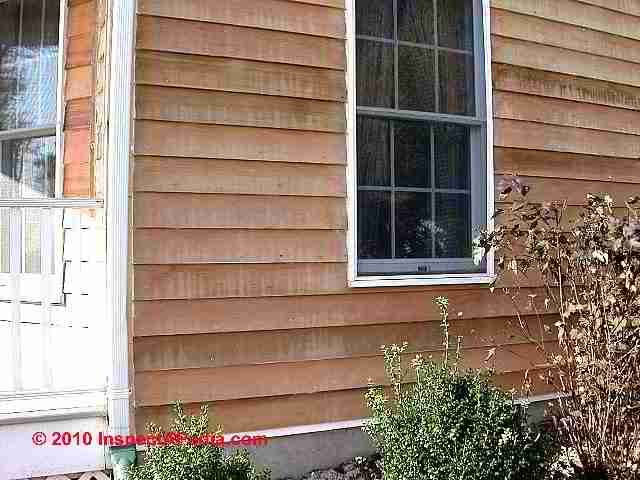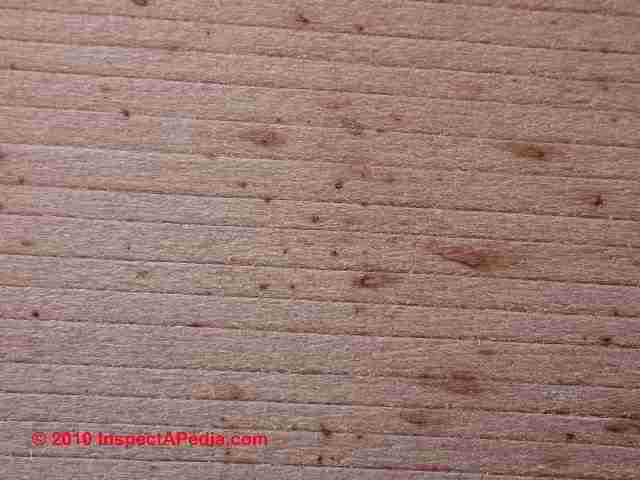 Extractive Bleeding Stains on Building Exterior Walls
Extractive Bleeding Stains on Building Exterior Walls
- POST a QUESTION or COMMENT about how to identify types & causes of stains on building exterior surfaces
Extractive bleeding stains on wood siding:
Building siding extractive bleeding stain cause diagnosis & cure or prevention.
This article series catalogs the different types of stains or discolorations found on building exterior surfaces: walls, roof, trim, walks, patios, decks, etc.
InspectAPedia tolerates no conflicts of interest. We have no relationship with advertisers, products, or services discussed at this website.
- Daniel Friedman, Publisher/Editor/Author - See WHO ARE WE?
Extractive Bleeding Stains or Marks on Building Siding, Walls, Trim
Cause & Prevention of Extractive Bleeding Stain Problems on Building Exterior Siding
 Our stained clapboard siding photo shown here is a closeup of stains found on the home shown in our photograph just above.
Our stained clapboard siding photo shown here is a closeup of stains found on the home shown in our photograph just above.
As reported in Best Practices Guide to Residential Construction (Steve Bliss, J Wiley & Sons) :
Excess moisture in wood species such as cedar, redwood, Douglas fir, and mahogany can dissolve the natural tannins in the wood and cause them to migrate to the surface, leaving a reddish-brown stain on the finish.
Sealers and stain-blocking primers help to minimize this problem but do not always eliminate it.
If staining occurs, the first step is to eliminate the moisture problem.
Then, if the extractive bleeding is mild, remove the stains with a mild detergent and water. More severe cases will require cleaning with an oxalic acid solution.
Carefully follow the manufacturer’s instructions when using oxalic acid, as the bleaching solution will harm plants and may bleach existing finishes on siding, trim, and other woodwork.
After washing, the oxalic acid must be thoroughly rinsed with clean water and the wood dried before finishing or refinishing. I
f the extractive bleeding has been allowed to bake in the sun, it may have hardened and be difficult to remove. In this case, you will need to apply a stain-blocking primer before refinishing.
Our clapboard staining photo below left shows staining in an inside corner below a roof valley where we suspect there was gutter spillage or leakage down the wall, exacerbating siding staining.
Look at the edge of the stains and you'll see some extractive bleeding.
[Click to enlarge any image]
Stains and stain prevention on red-cedar siding are discussed separately
Extractive Bleeding Stains - Research / References
- Burke, Edward, Norm Slavik (Chairs), UNDERSTANDING EXTRACTIVE BLEED [PDF] (2010) Joint Coating / Forest Products Committee: Extractives Task Force, Coatings Teh, March 2010 - retrieved 2022/12/21, original source: https://www.paint.org/wp-content/uploads/2021/09/Extractive-Bleed_Mar-2010.pdf
Excerpt: Extractives can be grouped into two broad categories—watersoluble extractives (WSE) and solvent-soluble extractives (SSE)— depending on the type of liquid in which they dissolve.
...
Continue reading at STAIN DIAGNOSIS on BUILDING EXTERIORS or select a topic from the closely-related articles below, or see the complete ARTICLE INDEX.
Or see these
Recommended Articles
- EXTRACTIVE BLEEDING on SHINGLES extractive bleeding stains on asphalt roofs
- MOLD APPEARANCE - STUFF THAT IS NOT MOLD
- PAINT FAILURE DICTIONARY - illustrated list of all types of paint failures
- STAIN DIAGNOSIS on BUILDING EXTERIORS - home
- STAINS on & in BUILDINGS, CAUSES & CURES - home
- STAINS on RED CEDAR SIDING - more stains on wood siding
Suggested citation for this web page
EXTRACTIVE BLEEDING SIDING STAINS at InspectApedia.com - online encyclopedia of building & environmental inspection, testing, diagnosis, repair, & problem prevention advice.
Or see this
INDEX to RELATED ARTICLES: ARTICLE INDEX to BUILDING STAINS
Or use the SEARCH BOX found below to Ask a Question or Search InspectApedia
Ask a Question or Search InspectApedia
Questions & answers or comments about how to identify types & causes of stains on building exterior surfaces.
Try the search box just below, or if you prefer, post a question or comment in the Comments box below and we will respond promptly.
Search the InspectApedia website
Note: appearance of your Comment below may be delayed: if your comment contains an image, photograph, web link, or text that looks to the software as if it might be a web link, your posting will appear after it has been approved by a moderator. Apologies for the delay.
Only one image can be added per comment but you can post as many comments, and therefore images, as you like.
You will not receive a notification when a response to your question has been posted.
Please bookmark this page to make it easy for you to check back for our response.
IF above you see "Comment Form is loading comments..." then COMMENT BOX - countable.ca / bawkbox.com IS NOT WORKING.
In any case you are welcome to send an email directly to us at InspectApedia.com at editor@inspectApedia.com
We'll reply to you directly. Please help us help you by noting, in your email, the URL of the InspectApedia page where you wanted to comment.
Citations & References
In addition to any citations in the article above, a full list is available on request.
- [1] Hugh Cairns, RHI (Registered Home Inspector), Subject 2 Inspections, Mr. Cairns is a licensed professional home inspector and thermographer serving Kelowna, Vernon, and Penticton, British Columbia. Tel: 250.808.5777, Email: okanagan@subject2homeinspections.com
- Analysis of Modern Paints, Thomas J.S. Learner, Research in Conservation, 2004 ISBN 0-89236-779-2 [Chemistry of modern paints, overview of analytical methods, pyrolysis-gas chromatography signatures of basic modern paints and their constituents, Fourier transform infrared spectroscopy for paint analysis, direct temperature-resolved mass spectrometry, and analysis in practice - technical reference useful for forensic paint science, focused on art works -DF]
- Building Pathology, Deterioration, Diagnostics, and Intervention, Samuel Y. Harris, P.E., AIA, Esq., ISBN 0-471-33172-4, John Wiley & Sons, 2001 [General building science-DF - ** Particularly useful text **
- Dampness in buildings, Diagnosis, Treatment, Instruments, T.A. Oxley & E.G. Gobert, ISBN 0-408-01463-6, Butterworths, 1983-1987 [General building science-DF]
- Certainteed Weatherboard fiber cement siding and trim products - see certainteed.com/ or see certainteed.com/resources/sidingandtrimspecsheet.pdf
- MASONITE WOODRUF® ROOFING OR MASONITE OMNIWOOD® SIDING LAWSUIT SETTLEMENT NOTICE - PDF file
- Paint Handbook: testing, selection, application, troubleshooting, surface preparation, etc., Guy E. Weismantel, Ed., McGraw Hill Book Company, 1981, ISBN-10: 0070690618, ISBN-13: 978-0070690615, [Excellent but a bit obsolete paint theory and practice, also a bit light on field investigation methods, out of print, available used-DF]
- Paint and Surface Coatings, Theory and Practice, R. Lambourne & T.A. Strivens, Ed., Woodhead Publishing Ltd., William Andrew Publishing, 1999 ISBN 1-85573-348 X & 1-884207-73-1 [This is perhaps the leading reference on modern paints and coatings, but is a difficult text to obtain, and is a bit short on field investigation methods - DF]
R. Lambourne was in the Research Department at ICI Paints Division and the Industrial Colloid Advisory Group, Birstol University, UK. - Seeing Through Paintings, Physical Examination in Art Historical Studies, Andrea Kirsh, Rustin S. Levenson, Materials in Fine Arts, 2000 ISBN 99-051835 [ forensic science, technical reference, focused on art works - DF]
- Sealants, Durability of Building Sealants (RILEM Proceedings), J.C. Beech, A.T. Wolf, Spon Press; illustrated edition (1995), ISBN-10: 0419210709, ISBN-13: 978-0419210702
- Soiling and Cleaning of Building Facades (RILEM Report), L.G.W. Verhoef (Editor), Routledge; 1 edition (November 3, 1988), ISBN-10: 0412306700, USBN-13: 978-0412306709
The report of a comprehensive investigation by RILEM which examines all aspects of the cleaning of facades, subject to soiling by both biological and non-biological agencies. The contributors are
international authorities working in this field giving essential advice to all those who need to know how to approach the problems connected with the soiling and cleaning of building facades. - Staining, Prevention of Premature Staining in New buildings, Phil Parnham, Taylor & Francis; 1996, ISBN-10: 0419171304, ISBN-13: 978-0419171300
The appearance of ugly staining early in a buildings life, ruins an otherwise pleasing appearance, tarnishes the image of the owners and gives rise to costly refurbishment works. In this book Phil Parnham raises a number of questions that should be considered whenever a new building is being designed or built.
These are:
* why has staining become so prominent;
* what causes premature staining; which parts of new buildings are likely to be affected;
* how can it be avoided?
By using a number of highly illustrated case studies, the author answers these questions and ends by suggesting measures that should be taken by all design and construction professionals to prevent premature staining. - In addition to citations & references found in this article, see the research citations given at the end of the related articles found at our suggested
CONTINUE READING or RECOMMENDED ARTICLES.
- Carson, Dunlop & Associates Ltd., 120 Carlton Street Suite 407, Toronto ON M5A 4K2. Tel: (416) 964-9415 1-800-268-7070 Email: info@carsondunlop.com. Alan Carson is a past president of ASHI, the American Society of Home Inspectors.
Thanks to Alan Carson and Bob Dunlop, for permission for InspectAPedia to use text excerpts from The HOME REFERENCE BOOK - the Encyclopedia of Homes and to use illustrations from The ILLUSTRATED HOME .
Carson Dunlop Associates provides extensive home inspection education and report writing material. In gratitude we provide links to tsome Carson Dunlop Associates products and services.


